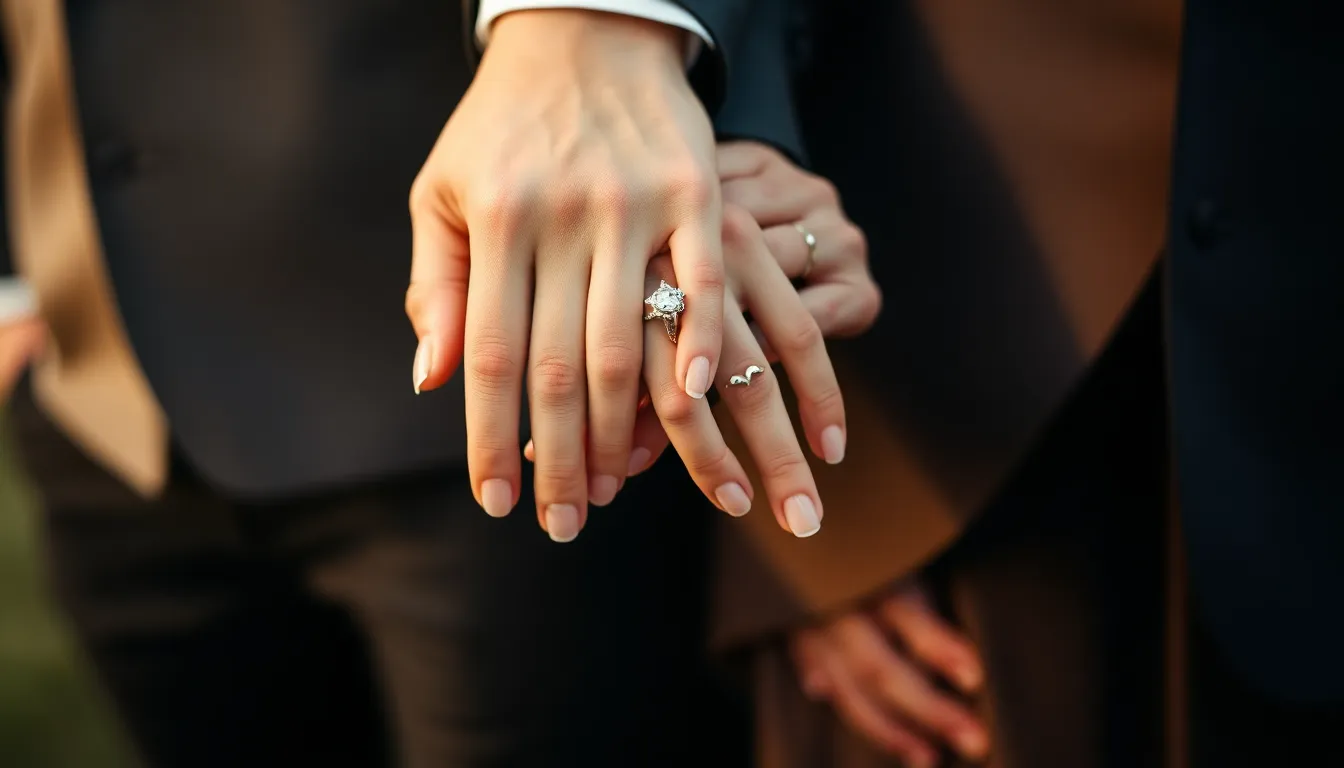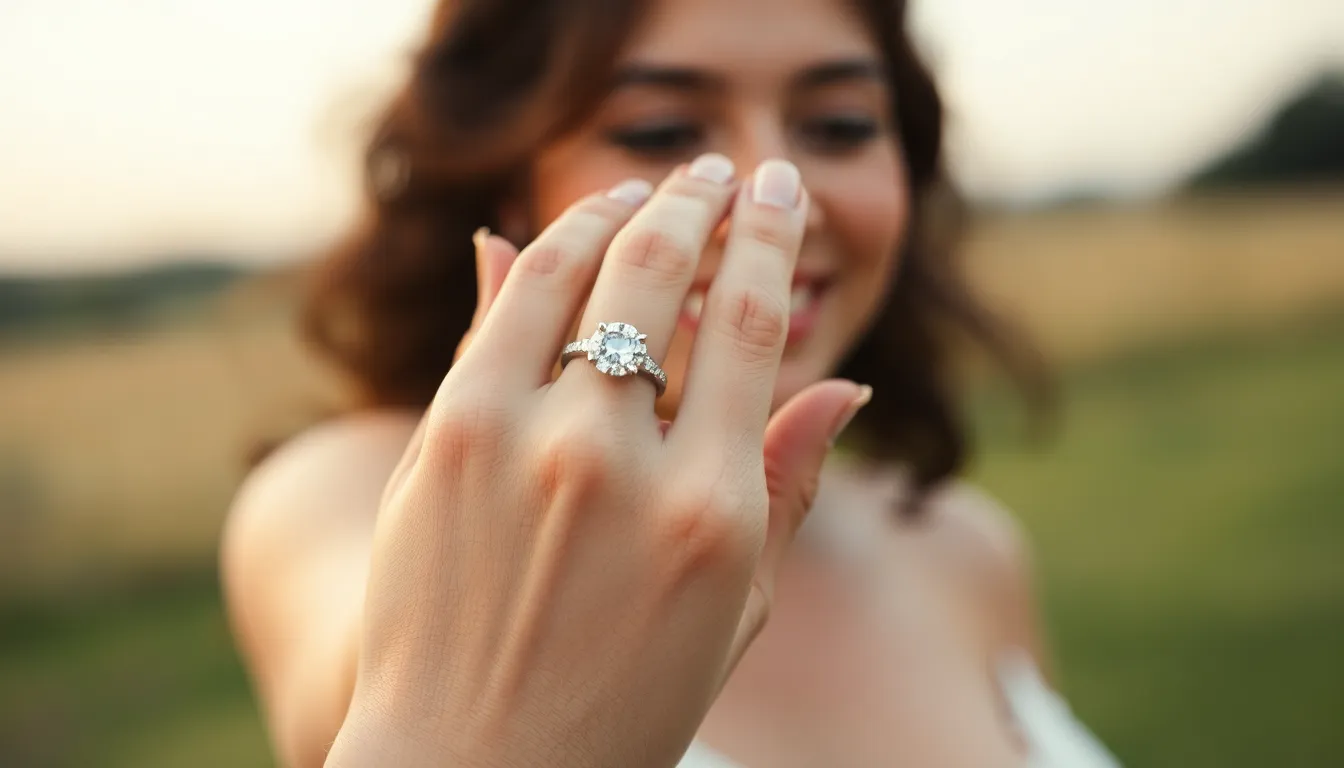Choosing the right hand for a wedding ring might seem like a trivial decision, but it’s a question that stirs up more debate than pineapple on pizza. While some cultures swear by the left hand, others firmly believe the right is where the magic happens. It’s like choosing between chocolate and vanilla—both are delicious, but one might just feel more right for you.
Table of Contents
ToggleUnderstanding Wedding Ring Traditions
Choosing the hand for a wedding ring often reflects deep-rooted traditions and personal beliefs. Variations exist across cultures, influencing how wedding rings are worn.
The Origins of Wedding Ring Placement
Rings have symbolized commitment for centuries. Ancient Egyptians placed rings on the fourth finger of the left hand, believing it contained the “vena amoris,” or the vein of love. In ancient Rome, couples adopted this tradition, marking engagement with a gold ring on the left hand. The practice spread through Europe as marriage customs evolved. As a result, modern Western societies typically follow this tradition. Meanwhile, some cultures prefer the right hand for significant rings. Awareness of these origins adds depth to the choice of hand.
Cultural Variations in Ring Wearing
Cultural nuances shape wedding ring practices globally. In Russia and some Eastern European countries, the right hand serves as the ring’s home, symbolizing strength and honor. India showcases another perspective, where couples often wear wedding rings on different fingers to convey specific meanings. Similarly, in the Philippines, it is common for couples to wear rings on the right hand during the engagement phase. Understanding these cultural variations enriches the discussion about wedding ring traditions and personal choices.
Wedding Ring Placement in Different Countries

Cultural norms dictate where individuals wear their wedding rings. This practice varies significantly across different regions and traditions.
North America
In North America, the common practice involves wearing wedding rings on the fourth finger of the left hand. This tradition connects to the belief in the “vena amoris.” Many couples, particularly in the United States and Canada, adopt this custom as a symbol of love and commitment. Some individuals place engagement rings on the same finger, allowing them to signify a continuous bond. Others may choose alternative placements for various personal or cultural reasons.
Europe
Europe showcases diverse practices regarding wedding ring placement. Countries like Germany and the Netherlands often favor wearing rings on the right hand. This choice symbolizes fidelity and commitment to marriage. In contrast, nations such as Italy and France typically follow the left-hand tradition. Several cultures across the continent reflect significant historical influences on their customs, offering a rich tapestry of wedding ring placement practices.
Asia
In Asia, wedding ring customs vary widely among different countries. In India, wedding rings often appear on the fourth finger of the right hand, which signifies honor and respect towards family traditions. Meanwhile, in China, some couples opt for wearing rings on the left hand as a sign of eternal love. The diversity of Asian wedding ring practices illustrates the importance of cultural values and beliefs in shaping personal choices and traditions in marriage.
The Meaning Behind Ring Placement
The placement of a wedding ring carries deep symbolism and varies across cultures. Understanding these meanings adds depth to the decision-making process.
Symbolism of the Left Hand
Traditionally, wearing a wedding ring on the left hand connects to the belief in the “vena amoris.” This ancient notion suggests a direct link from the fourth finger to the heart. Cultures such as those in North America, the UK, and most Western nations generally adopt this practice. Placing the ring here symbolizes love and commitment. The emphasis on the left hand highlights its emotional significance in marriages.
Significance of the Right Hand
In contrast, many cultures view the right hand as a symbol of strength and honor. Countries like Russia, India, and parts of Eastern Europe often opt for right-hand placements. This choice reflects various cultural beliefs, including protection and fidelity. By choosing the right hand, couples often align their wedding rings with broader traditions surrounding marriage. The significance of the right hand can promote a sense of unity and shared values among partners.
Personal Preferences and Modern Trends
Personal preferences play a significant role in deciding which hand to wear a wedding ring on. Tradition often guides this decision, yet many choose based on comfort or personal style. In contemporary society, individuals may opt for the right hand due to its symbolism of strength and honor.
Choosing the Right Hand for You
Choosing the right hand for wearing your wedding ring reflects personal sentiment. Some people gravitate toward the left hand, embracing tradition and the longstanding belief in the “vena amoris.” Conversely, others might select the right hand to signify individuality or cultural significance. Emphasis on personal beliefs, lifestyle, and regional customs influences this choice significantly.
Alternative Ring Styles and Their Placement
Alternative ring styles often lead to diverse placements. Many modern couples choose stacked rings, wearing them on either hand depending on preferences. Unique styles, such as statement rings or custom designs, can also inspire alternative placements beyond the traditional fourth finger. Certain materials and designs may even dictate which hand feels more appropriate for expression of personal taste. Overall, factors like personal meaning and cultural background greatly influence ring placement decisions.
Choosing which hand to wear a wedding ring on is a deeply personal decision influenced by cultural traditions and individual beliefs. Whether one opts for the left hand to symbolize love or the right hand to convey strength, the choice carries significant meaning.
Ultimately, it’s about what resonates most with the couple. As they navigate this tradition, they also embrace their unique identity and values. The beauty of this decision lies in its ability to reflect personal sentiment while honoring the rich history of wedding ring customs across the globe. Each ring tells a story that goes beyond mere adornment, celebrating love in all its forms.




